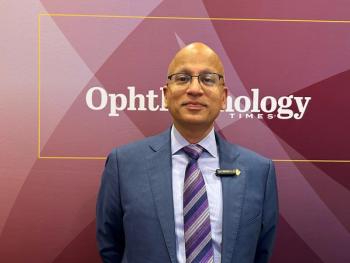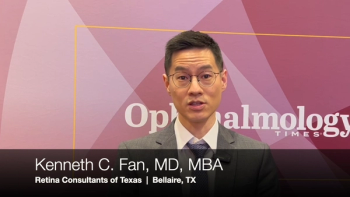
Thinking outside the cone: Over, above standard approach
All of these cases scenarios, which are an everyday occurrence in my practice, demonstrate my desire to take every patient to emmetropia despite the “so-called” complexity of the cases.
Gloves Off with Gulani
Dr. GulaniIn this continuation that presents more scenarios of keratoconus and their management, let’s first briefly recap the discussion in the previous “Gloves off with Gulani” column, “Thinking outside the cone: Keratoconus as a refractive surgery,” as well as some principles we covered during the case discussion (
When we consider a condition such as keratoconus as a refractive disorder, the mindset then shifts from salvaging the eye to actually bringing it to visual excellence despite the cone. We talked about various modalities, concepts, and classification systems that I have discussed over two decades, and we reviewed some case scenarios in the previous column.
Therefore, I want to approach every case of keratoconus with the mindset that the eye can possibly reach the best visual outcome by using all the available technologies and techniques, performed singly or in staged combinations, to the patient’s best advantage. All images are courtesy of Arun C. Gulani, MD.
Case scenarios
Figure 1
In these case scenarios, I will quickly review placement of Intacs segments (Addition Technology) using the Gulani-Donnenfeld concept of entry into the cornea at the 12 o’clock position, although the segment placement still can be on the steep axis at any orientation.
Figure 2
In such cases, even following placement of the Intacs segments, laser advanced surface ablation (ASA) can be performed to fine tune the refractive error to safely bring the patient to emmetropia.
Figure 3
In these patients with ectasia, the refractive error was controlled by asymmetric placement of the Intacs segments in a directional fashion to facilitate manipulation of the cornea.
Figure 4
The Intacs can be used directionally to decrease the astigmatism. In this patient, the astigmatism is reduced from a preoperative value of 7.4 to 0.6 D, with a resultant immediate improvement in the vision. There is also the potential for more visual improvement later if laser ASA needs to be performed.
Figure 5
Intacs segments can be implanted not only to decrease the keratometry values to a more normal range but also can be followed by laser ASA surgery to bring the eye to emmetropia.
Figure 6
This patient has extensive ectasia with abnormal vision despite Intacs surgery performed by his LASIK surgeon. After the eye was confirmed to be stable, laser ASA was performed to achieve a markedly improved visual outcome from 20/400 preoperatively to 20/30 postoperatively, a result that to this patient was nearly 100%.
Figure 7
Crosslinking also can be performed before or after corneal manipulation with Intacs or Intacs combined with conductive keratoplasty or even after staged procedures such as laser with an implantable collamer lens (ICL) to make the visual end point stable and permanent.
Figures 8 to 10
The patient presented after having undergone Intacs placement to treat keratoconus followed by crosslinking, but the vision remained extremely poor. Considering that the patient had already undergone these procedures, my principle is always to respect the work of the previous surgeon, and therefore, I opted to perform laser ASA surgery following a refractive evaluation in order to achieve emmetropia. Figure 10 summarizes the treatment that resulted in a happy patient with 20/20 vision.
Figures 11 and 12
There are always cases in which surgeons should not maintain a low threshold to perform surgical acrobatics. Refraction is the most important driving force in the quest for emmetropia. This patient showcases that concept. This patient was referred to me after breakage of his Ferrara rings (Ferrara Ophthalmics); these rings had been implanted outside of the US. The refractive examination showed that, despite the appearance of the rings, the patient was still best corrected to emmetropia. Because the previous surgeon had done an excellent job, I opted to laser the cornea and correct the astigmatism to reach emmetropia.
Figure 13
When corneas with keratoconus are more unstable and they cannot be directionally improved, they must be rebuilt using various lamellar techniques. In this patient, the resultant lamellar keratoplasty results in normalization of the cornea.
Figure 14
The lesson this figure emphasizes is that surgeons should not become so enamored by topography that their desire for perfection is decreased. Although topography indicates the patient has form fruste keratoconus, as long as stability and accuracy of corneal measurement is confirmed, implantation of premium IOL implants, such as toric IOLs, can be performed.
Figure 15
A similar scenario to that in the previous case scenario is seen in this figure, which documents that while the cornea is abnormal, lowering the surgical expectations is unacceptable.
Figure 16
This figure shows various presentations of patients who have keratoconus and have undergone incisional surgeries to treat the keratoconus and also might have associated cataracts.
Conclusion
All of these cases scenarios, which are an everyday occurrence in my practice, demonstrate my desire to take every patient to emmetropia despite the “so-called” complexity of the cases.
This desire leads us to neutralize our mindset like that of a mathematician to solve the problem beyond the published formulas that are taught for addressing these scenarios in most cases, of course, with patient safety and their vision goals being the backbone of these concepts. This allows us to develop unique vision recipes for each patient and bring them to uncorrected emmetropia.
I encourage you to understand each equation to help you create a unique formula for each case. May I encourage you to “think outside the cone.”
Arun C. Gulani, MD is founding director and chief surgeon of the Gulani Vision Institute, Jacksonville, FL. Dr. Gulani has no financial interests to declare.
Newsletter
Don’t miss out—get Ophthalmology Times updates on the latest clinical advancements and expert interviews, straight to your inbox.



















































.png)


